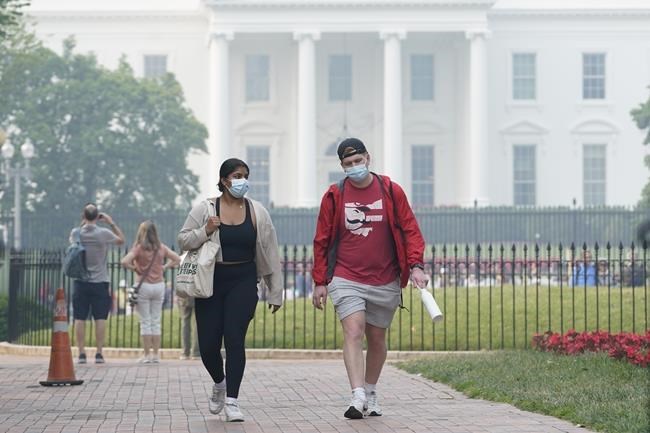WASHINGTON — A fiery orange sun rose over the iconic landmarks of Washington, D.C., before all but vanishing into a grey Canadian haze Thursday as wildfire smoke from Ontario and Quebec arrived in earnest in the U.S. capital.
But the smoky sky appeared to do little to deter the typical pattern of life in one of America's most-visited cities, where crowds of tourists and school groups congregated as usual at museums, memorials and monuments.
"When we went outside, we expected it to be much worse than it actually is," said Hans Müeller, a resident of Frankfurt who was on a two-week vacation in the U.S. and Canada with his girlfriend Juliane.
"Sometimes there's something like a burned smell in the air, definitely — but not all the time. Sometimes it comes to your nose and you think, 'Ah, OK, now I can smell it.' But maybe that's because we think we can smell it."
The city escalated its air quality alert Thursday from red to purple — one notch below the dreaded maroon alert, indicating hazardous air conditions, which was in effect throughout parts of Maryland, including Baltimore.
But in D.C., it was more visibly apparent than anything, which is why Müeller was among the relative minority of people wearing their pandemic-era face masks while walking around outside.
"It feels safer with the mask on, especially when we're reading that the air quality is so terrible," he said. "The Washington Monument is basically not (visible) from this point, so you definitely see that there's something there."
It was a far cry from the previous day's reaction in New York, which has so far appeared to bear the brunt of the impact, its skyline gradually returning after it spent much of Wednesday behind an imposing and perilous orange veil.
"Blame Canada!" the all-caps front page of the New York Post shouted Thursday, describing the "eerie, smoky hell" as a product of "Eh!pocalypse now."
As the smoke continued to drift south, more and more U.S. cities along the Eastern Seaboard took precautionary measures — closing zoos, keeping schoolchildren indoors and cancelling outdoor activities and sporting events.
The White House postponed an outdoor Pride event that had been scheduled to take place.
President Joe Biden spoke by phone Wednesday with Prime Minister Justin Trudeau and extended his offer of additional help.
More than 600 U.S. firefighters, support personnel and firefighting assets, including water bombers, have already been deployed north and more are on offer, Biden said in a statement Thursday.
They are "working alongside Canadian firefighters to tackle what is likely to be the worst fire season in Canadian history, and one that has huge impacts here in the United States," he said.
"Yesterday I spoke with Prime Minister Trudeau and offered any additional help Canada needs to rapidly accelerate the effort to put out these fires, particularly those in Quebec, where the fires are having the most direct impacts on American communities."
The U.S. National Interagency Fire Center is standing by for any Canadian requests for further assistance, while Transportation Secretary Pete Buttigieg braces for cascading flight delays as major airports impose periodic ground stops.
Outside the White House, Stanton, Va., retiree Dave Copper — clad in a face mask and "Stop Fracking Pipelines" T-shirt — was on his way home from a protest against the latest Biden administration decision in favour of fossil fuels.
Copper said he doesn't understand how Biden can rail against climate change in one breath, then turn around and sign off on West Virginia's controversial Mountain Valley pipeline project in the next.
"There's too much junk in the air," he said of the people walking past him wearing masks.
"Climate change? I'd bet my bottom dollar on it. And something needs to be done. The climate change president has turned out to be another sellout to the oil and gas companies. What a surprise."
The smoke is arriving in the U.S. capital at an interesting moment for policymakers, with tension between American dependence on fossil fuels and the climate prerogative of expanding green energy projects.
On Tuesday, climate activists interrupted an event in D.C. with West Virginia Sen. Joe Manchin, whose status as a moderate Democrat in a ruby-red state has made him a coveted ally in a narrowly divided Congress.
That's a big part of how Manchin was able to secure approvals for the Mountain Valley project as part of the debt-ceiling agreement Biden signed over the weekend.
And in March, Biden enraged environmental groups when he approved the Willow project, which will allow energy giant ConocoPhillips to develop three drill sites in the petroleum-rich North Slope region of western Alaska.
Critics say Willow will be a "carbon bomb" that could produce upwards of 300 million tonnes of pollution over the next three decades, effectively hamstringing Biden's own efforts to ease U.S. fossil fuel dependence.
"It's counterintuitive, it's just not right," Copper said. "We have to change it, because, you know, we've dragged our feet for so long now."
This report by The Canadian Press was first published June 8, 2023.
James McCarten, The Canadian Press


